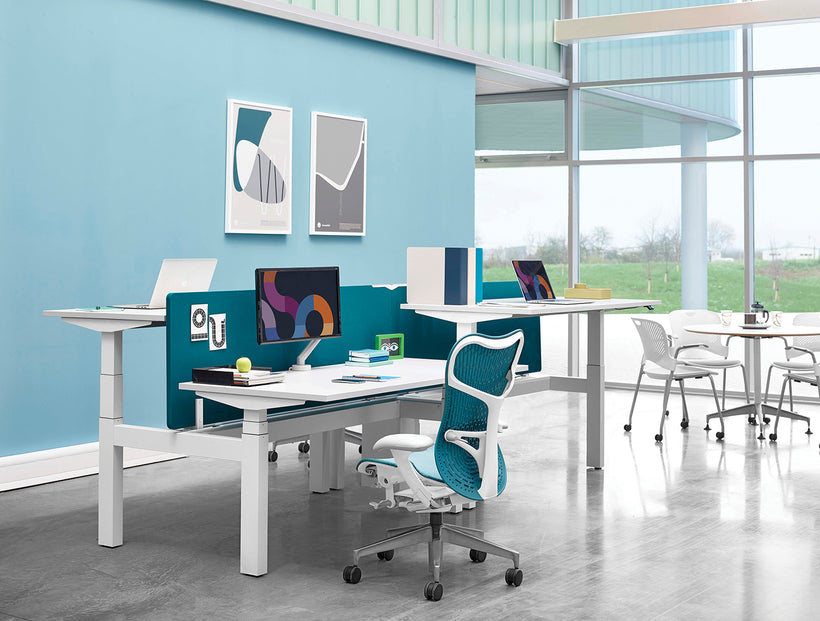A Breakdown of Ergonomics for Office Workers
by Wade Larkin on

Ergonomics for office workers is a science-based discipline that modifies desk and office behaviours for a healthier and more productive working environment.
In 2019, WorkSafe Australia provided a detailed report on the causes, impacts and prevention of work-related musculoskeletal disorders. The research revealed that more office workers were experiencing musculoskeletal injuries in the office as a direct result of poor workplace interactions. As such, the study of ergonomics and implementation of ergonomic furniture works to mitigate and negate the risks associated with poor workplace and office interactions.
NPS Commercial Furniture, Townsville's leading provider of innovative, exceptionally designed ergonomic furniture, are here to break down ergonomic elements relevant to office workers.
Ergonomic Considerations for Office Workplaces
Ergonomics is the application of psychological and physiological principals to the engineering, design and manufacturing of products, systems or processes. In the case of ergonomics for office workers, this refers to the design and manufacturing of office furniture, accessories and implementation of healthy behaviours.
Careful consideration of workplace ergonomics can help provide a more comfortable working environment for workers, lowering their stress levels and reducing the risk of injuries caused by awkward positioning and repetitive strain. Ergonomic requirements for office environments are not merely about having a good chair and your desk at the right height. Desk job ergonomics highlight the lighting, relative humidity, air quality and workstation design that can improve workplace interactions.
Workplace ergonomics calls attention to the ways in which desk workers interact with their working environment and how these interactions can be enhanced to improve overall wellbeing and health. Using ergonomic guidelines can also significantly reduce the risk of musculoskeletal injuries, sedentary behaviour and both poor physical and mental health.
Whether you're setting up a new office space or adapting your existing workstation, here are some ergonomic factors to consider:
1. Positioning
Sitting position while at your desk is a huge component of ergonomics for office workers. The correct working position means adapting your office chair, workstation or desk and monitor to meet the demands of a healthy working posture.
Ergonomic Chairs
Ergonomic task chairs directly address the lumbar support, height and angles that a person should be seated at while working at a desk. Ergonomic chairs should support the spine's natural curves and provide ample space for a desk worker to stay comfortable throughout the working day. A chair's height should allow the occupant's feet to rest flat on the floor and thighs parallel to the floor. NPS Commercial Furniture offer a wide range of ergonomic task, drafting chairs, meeting chairs and executive chairs that offer superior comfort and support.
Standing Desks
Height adjustable desks are an ideal workstation set-up, allowing a work environment to be customised to each employee's height and monitor style. Ergonomic requirements for office environments include having clearance for knees, thighs and feet under the desk when sitting. Height adjustable desks are also an excellent way to break up the working day with bouts of working from a standing position in between sitting for periods of time.
Monitors and Desk Accessories
Desk job ergonomics also include adapting the position of your monitor or desktop screen. Your monitor should be roughly an arm's length away, with the top of the screen at eye level or just below for the right angles. By having your monitor, keyboard, mouse and other desk accessories easily accessible and correctly positioned, you’re reducing the risk of any strain or awkward movement.
Monitor arms are useful tools in achieving the ideal screen height requirements for each employee. Not only will this handy ergonomic accessory aid in reducing incidents of back pain and injury in the workplace but they also help to cut the clutter on desktops; ensuring optimal workflow and streamlined aesthetics.
2. Environment
The environment in which we work plays an enormous role in ergonomics for office workers. Adapting the lighting, air quality and noise to meet ergonomic requirements for office environments can go a long way in creating a comfortable, productive and healthy workplace.
Appropriate lighting, without glare or shadows, can reduce eye fatigue and headaches while working. Natural lighting in an office should be maximised and employers need to ensure that an entire office has adequate lighting to reduce eyes from working overtime. The office space should be at a comfortable temperature and acoustic dividers or acoustic booths should be utilised to combat noise pollution in a busy office.
3. Working Behaviours
Working style and organisation is also an important element of ergonomics for office workers. Healthy ergonomic habits include:
- Taking frequent breaks throughout the working day;
- Avoiding long periods of repetitive activity;
- Fostering an organised environment; and
- monitoring any unhealthy working behaviours.
When ergonomic changes are made, which allow employees to work "smarter" rather than "harder", productivity and quality of work are bound to improve in the office.
How to Implement Ergonomics in the Office Workplace
Implementing ergonomics in the office workplace is key to ensuring your employees have access to a safe, comfortable and healthy working environment. The innovative and ergonomic design experts, NPS Commercial Furniture, offer an exclusive range of office furniture that meets the unique ergonomic demands of a variety of modern workplaces in Australia.
If you'd like to learn more about our range of ergonomic furniture, do not hesitate to get in touch with one of our friendly team members. Available across North Queensland, including Townsville, Cairns, Mackay, Rockhampton and Mount Isa, NPS Commercial Furniture are pleased to provide a stylish collection of pieces that prioritise commercial and office employees' safety, comfort, and integrity.
